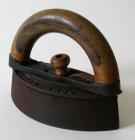1
Farm Electrification transformed the lives of the farm families. Electricity provided a means to perform farm duties in different ways, from cooking to outside chores. The processes of farm labour were changed, electricity provided relief from farm drudgery and backbreaking chores. Life before electricity on the farm was strenuous and the following display shows a comparison of how non-electric and electric appliances work.
2
The shift from wood or coal burning stoves to electric stoves was not an easy transition for farm women. Although electric stoves were touted as easy and efficient, the users had to make a change in their cooking practices. Nellie Kedzie-Jones, a Home Economist, who contributed to the farm journal 'The Country Gentleman' from 1912 - 1916, wrote that, "The best [kitchen range] is none too good. You had better economize anywhere else than on that. Good cookery is impossible on a poor stove." She recommended that farm women should have a large six-hole stove, with a firebox large enough to hold "quite big wood," a damper in the stovepipe "a wonderful fuel saver" and a large water reservoir "you can't have too much hot water." Moreover, Nellie spoke highly of the "indispensable" warming oven, baking ovens with glass doors, "and of course a thermometer. Without it your baking is guesswork." Nellie gave directions to farm women on buying a good stove for efficient cooking.
3
A wood and electric stove manufactured by Gurney.
1930

4
In 1881, Helen Campbell provided directions to farm women for the tending the fire in a stove. The manual stated:
"First, dispose of the cinders in the grate; replace the lids; close the doors and drafts; dump the cinders and ashes into a pan below the grate and sift either in a sifter built into the stove or in a regular ash sifter; set a fire with shavings or paper, small sticks of wood, and a few larger pieces; reopen the drafts, light the fire, add large pieces of wood or coal; now close the dampers."
If a good fire caught in the proper stove it would last four hours. The above demonstrates the amount of work that went into maintaining the stove for both cooking and heating in the farmhouse. To further reiterate this, an experiment was done at the Boston School of Housekeeping in 1899. Over six days:
"... twenty minutes were spent in sifting ashes, twenty-four minutes in laying fires, one hour and forty-eight minutes in tending fires, thirty minutes in emptying ashes, fifteen minutes in carrying coal, and two hours and nine minutes on blacking the stove to keep it from rusting."
The above seems to only apply if things were going well with the stove. If dampers were being affected by the wind or flues were blocked, the fire would be more finicky. Although the Boston test was done in 1899 the majority of stoves on the farms of Manitoba would have been from around this period. The farm motto has always been: if it still works don't throw it out.
5
An electric stove manufactured by Gurney.
1952

6
Electric Stoves were quite a contrast to the wood or coal burning cast iron stove. Before purchasing, the farm women would have to have knowledge about what she primarily used the stove for aside from domestic cooking. Did the farm woman create a great amount of preserves or run a small bakery as a sideline? These questions would determine what size of stove the farm woman would need. Also, before the stove was purchased the proper wiring would have to be installed in the house. Once the stove was in the house and wired in, the farm woman would have to experiment with cooking on it. A concept of temperature gauges, and how to manipulate them, was needed for both the range and the oven in order to produce edible fare. Thus, time and practice were essential for this newly advertised quick and efficient electric stove.
7
Mrs Pott's sad iron.
1900

8
Ironing was a labourious task in the late nineteenth and early twentieth century. The farm woman ironed everything from handkerchiefs to sheets. The sad iron was the implement used to rid material of unwanted wrinkles and creases. This iron was cast iron and was heated on top of the wood or coal stove. The sad iron was heavy and hot, and ironing was a task not well embraced but deemed necessary. Clothing would be sprinkled with water then rolled and placed in a basket. The iron would be placed on the stove to heat. There was no thermostat control so literally practice made perfect. The clothing was then placed on a board and pressed with the iron going back on the stove as it cooled down to be reheated.
9
A steam and dry iron manufactured by General Electric.
1950

10
Electric irons were introduced quite early on, in 1893, however, farm women in Manitoba were a long way from even getting electricity. In the 1942 Farm Electrification survey of Manitoba the iron ranked second on the list of appliances desired for the home. The farm women deemed it to be a labour saving device. They could iron away from the hot stove in a cooler room and not singe or burn expensive clothing. One farm woman in Ashern, Manitoba, when asked what her first electric appliance was, replied, "An iron of course!" when asked why she replied, "Because we ironed everything in those days." Here a small but powerful device minimized labour of the farm woman and was affordable and useful.
11
A coal oil lantern manufactured by Beacon GSW.
1900

12
Artificial lighting was a necessity on farms, not only to continue domesticity in the household but also to check livestock in the barn. Coal oil and kerosene lamps provided an early means of lighting on the farm. Kerosene was invented in 1854 and became the steadfast fuel to bring light into the darkness. Kerosene lamps were useful but not easy to care for. Lamps needed daily chimney wiping and wick trimming; weekly washing of the chimney and shades; periodic re-wicking and dismantling for thorough cleaning with soda, inside and out. To gain the benefits of light required work. Also, there was the danger of damage to the eyes with excessive heat. It has been said, that it is "Better to burn a larger flame, and keep it at a greater distance." This would have been difficult when carrying the lamp to the barn. Also, when handling a lantern one hand was always occupied with illumination, leaving the farmer with only one hand to work. The immense potential of starting a fire would have been the greatest fear.
13
A living room lamp.
1939

14
Electric light caused quite a stir on the farm and tasks became safer and easier. The yard light was revolutionary. Farmers could now see their property, watch the livestock and feel comforted to know that everything was ok. Barns could be lighted providing access and visibility to livestock; especially important during calving or if an animal was ill. Electric light also added two to four hours a day of potential working time, providing more flexibility in the planning of daily events. Domestic space within the house changed; instead of all reading at the kitchen table, privacy could be had in other rooms.





